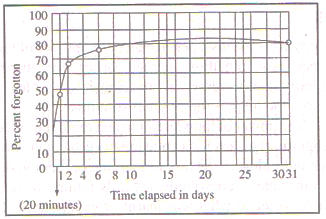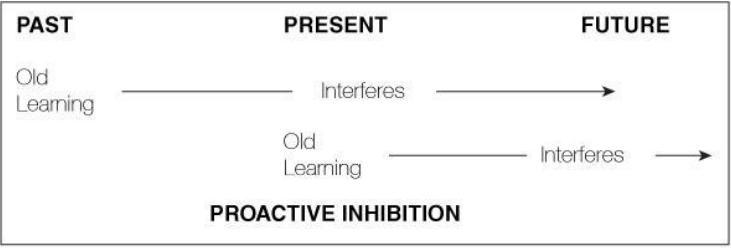Table of Contents
Forgetting is failure to retrieve information from long term memory store. It refers to failure to either recall or retain information into present consciousness. Here we are going to learn Forgetting in psychology which contains types, curves of forgetting.
FORGETTING
Forgetting
“Forgetting is the loss, permanent or temporary of the ability to recall or recognizing something learned earlier” Munn (1967).
Types of Forgetting
It may be broadly classified as natural and morbid forgetting.
- In natural forgetting, forgetting occurs with the laps of time in a quite normal way without any intention of forgetting on the pair of the individual while in morbid or abnormal forgetting one deliberately tries to forget something.
- According to another view, forgetting may be classified as general or specific. In general forgetfulness, one suffers a total loss in one’s recall or some previous learning while is specific forgetfulness the individual forgets only one or the other specific parts of his earlier learning.
Curve of Forgetting
Studies done by the psychologist Ebbinghaus (1885) represents the earliest systematic work in studying the phenomenon of forgetting. He himself worked as a subject for these studies and described his results by plotting a curve for forgetting. He memorized a list of non-sense syllabus and then tested himself at intervals varying from 20 minutes to a month to see how much of the list he remembered. The result in terms of the percentage of material forgotten with the lapse of time were as follows :
Time elapsed Amount forgotten
20 minutes 47 %
One day 66 %
Two days 72 %
Six day 75 %
Thirty one days 79 %
He plotted the data as a graph as shown below –

Ebbinghaus concluded that (a) The amount learnt material forgotten depends upon the time lapsed after learning. And (b) The rate of forgetting is very rapid at first and then gradually diminishes proportionately as the interval lengthens.
Interference
Interference is major cause of forgetting. General understanding of the subject suggests that “Information gets confused with other information in our Long-Term Memory.”
Types of Interference
▪ Retroactive Interference
▪ Proactive Interference
Retroactive Interference
A mix up of previously learned information with new and similar information is called Retroactive information.
Example: A student studies and understands the events and causes of World-War I thoroughly. After few weeks, the student studies events and causes of World-War II. If the student then fails to remember the events and causes of First World-War, this would be an example of Retroactive Interference.
Proactive Interference
The phenomenon where the student fails to remember new information having mixed it with similar previous information is called Proactive Interference.

Example: Like the previous example, a student studies and understands the events and causes of World-War I in depth. After few weeks, the student studies events and causes of World War II. If the student then fails to remember the events and causes of Second World-War, this would be an example of Proactive Interference
Download Forgetting PDF(In English)
Download Forgetting PDF(In Hindi)





 BPSC TRE 4.0 Increased Women Reservation...
BPSC TRE 4.0 Increased Women Reservation...
 CSIR NET City Intimation Slip 2025, Down...
CSIR NET City Intimation Slip 2025, Down...
 West Bengal Teacher Recruitment 2025 Not...
West Bengal Teacher Recruitment 2025 Not...




